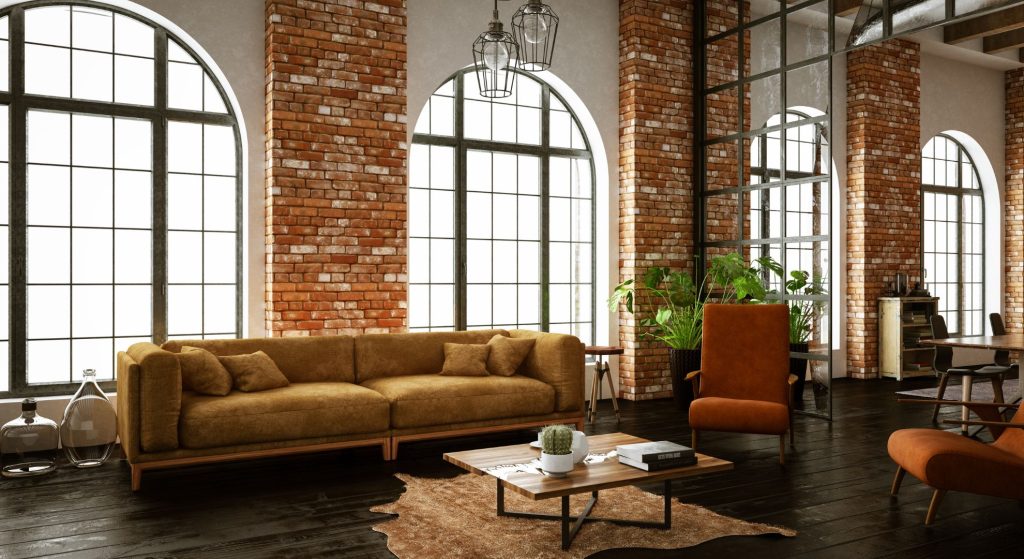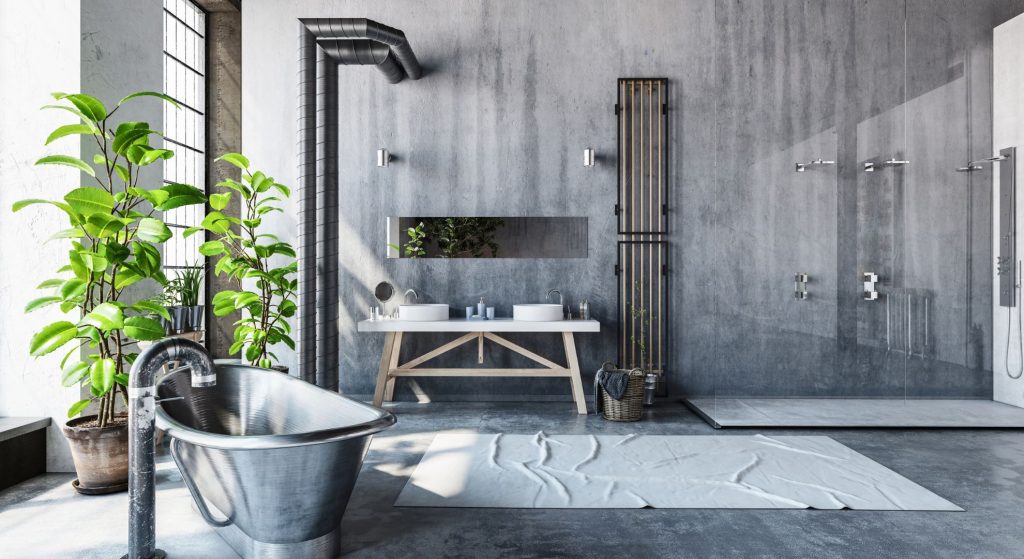A Symphony of Style, Function, and History
As an art historian deeply occupied in the interplay between form, function, and historical context, I am fascinated by the stark beauty of industrial design interior. This vibe is defined by its celebration of utilitarian roots, exposed brick, raw metals, and reclaimed wood.
Industrial vibe decor not only booms a rich legacy of flexibility but also serves as a canvas for the peaceful simplicity of Minimalism and the functional elegance of Modernism. This blend transforms traditional spaces into sophisticated, contemporary havens.
The Crux of Industrial Style

Industrial-style interior design is a bold declaration of the building’s structural soul. This design philosophy showcases the raw beauty of architectural frameworks and materials, from rough ductwork to polished concrete floors.
Industrial interior design is not about covering but proudly displaying each element, thereby creating a distinctive charm that marries the raw with the refined.
The Historical Roots of Industrial Decor
Born in the vast, uninhibited factories of the early 20th century, industrial interior design has evolved as cities have expanded. These once-waste spaces, repurposed through adaptive reuse by visionary designers and architects, have been transformed into trendy lofts, bustling offices, and vibrant commercial hubs.
These spaces now celebrate their industrial past while preserving their intrinsic architectural elements and adapting to modern functional needs.
Today, industrial vibe decor is valued for its unique ability to merge historical integrity with innovative design, creating functional and lovely spaces.
Minimalism and Industrial Vibe
Compared to industrial complexity, Minimalism champions the philosophy of “less is more.” This style is defined by its emphasis on simplicity, clean lines, and a monochromatic palette, focusing on functionality and eliminating clutter.
When paired with industrial design, Minimalism tempers the visual intensity of industrial elements, increasing a calm and orderly ambiance.
Modernism and Industrial Vibe
Modern industrial interior design draws inspiration from Modernism, which emphasizes functionality, simplicity, and modern materials.
Originating as a counter to decorative traditional styles, Modernism in industrial settings highlights clean lines and organic forms. It celebrates design innovation, perfectly complementing the rough authenticity of industrial elements with the sleek aesthetics of Minimalism.
Key Elements of Industrial Interior Design

Industrial interior design thrives on a foundation of authenticity and utility. Here are the defining features:
- Exposed Beams and High Ceilings: Intensifying the sense of space, these elements infuse any area with an open, airy feel.
- Exposed Brick Walls: These walls add a touch of unrefined beauty and texture, which is symbolic of industrial design.
- Visible Piping and Ductwork: Celebrated for their practical appeal, these elements highlight the functional aesthetics of the design.
- Iron, Steel, and Metals: Essential for crafting an authentic industrial vibe, these materials are chosen for their toughness and minimalistic flair.
- Wood Accents: Wood brings warmth and natural texture, balancing the cooler metals.
- Concrete Floors and Surfaces: Durable and strong, concrete enhances the industrial feel while offering a versatile base for various decor styles.
These materials are intentionally left unfinished, highlighting the space’s industrial heritage and blending roughness with sophisticated design principles.
A Harmonious Blend
Merging industrial interior design with Minimalism and Modernism is an artful dialogue between the raw and the refined. Here’s how this fusion elevates contemporary spaces:
- Neutral Palette with Strategic Accents: Start with a minimalist base of whites, beiges, and grays. Introduce warm tones of exposed brick and cool metal touches punctuated by bold color accents in artwork or furnishings for added depth.
- Thoughtful Material Mix: Combine rough textures like wood, metal, and concrete with sleek Modernist surfaces for a rich sensory experience.
- Open Space Emphasis: Keep layouts open and airy while incorporating distinctive industrial features like high ceilings and large windows to enhance spatial dynamics.
- Furniture Selection: Choose pieces that reflect Modernist simplicity and functionality but are crafted from materials that nod to industrial aesthetics.
- Sparing Use of Art and Accessories: Opt for a few key pieces that highlight the space’s industrial roots or modernist sculptures that serve as focal points without adding clutter.
This synthesis of styles creates visually appealing spaces that occupy history and functionality, representing a lifestyle that values all three equally. It’s more than a design choice; it’s a way to create timeless and distinctly modern reservations.
Conclusion
Combining industrial design with elements of Minimalism and Modernism does more than enhance aesthetics; it creates functional, timeless spaces that bridge the gap between historical authenticity and modern comfort.
This blend respects traditional elements while incorporating modern innovation, producing interiors that are not only visually prominent but also deeply meaningful.
By embracing this fusion, we celebrate a design approach that values simplicity, functionality, and the unique story of each space, ensuring our living environments are both beautiful and practical. modern.
